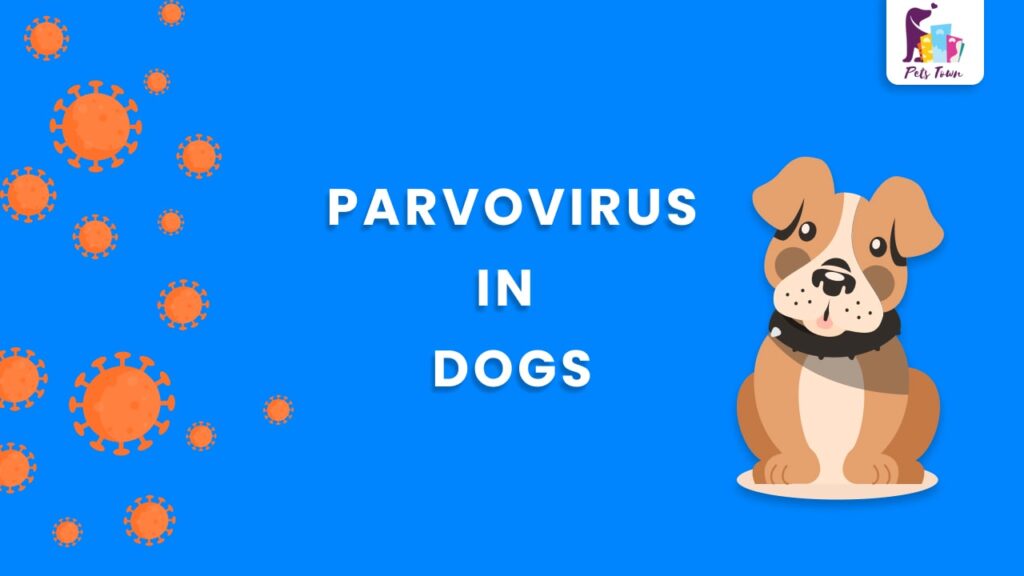GENETICAL NAME :
Canine parvovirus type 2 is such a disease that is said to have first emerged in Europe around 1976 among dogs and soon it became a widespread disease affecting dogs worldwide resulting in the inflammation of gastroenteritis.

WHAT Parvo Virus IS ??
Parvovirus is generally of two types: intestinal parvovirus and cardiac form. It is said to be highly contagious by the vets as it replicates in the lymphoid tissue of the oropharynx and spreads to the rest of the body by the blood. Vets often say that parvovirus destroys the lining of the GI tract and impairs the ability to observe nutrients and water…
WHICH DOGS ARE MORE SUSCEPTIBLE TO ??
Puppies between 6 weeks to 5 months are more susceptible to parvovirus while ADL dogs as well can catch this disease very easy especially those without any vaccines or incomplete series The other breeds which can easily catch parvovirus are are pit Bulls, Doberman, Rottweilers, Labrador retriever, German shepherd, and Alaskan sled dogs…
canine parvovirus SYMPTOMS :
Are your dogs affected by canine parvovirus ?? Confused about what to do and whom to contact, please don’t be confused. Contact your vet as early as possible because it’s a very deadly disease that attacks the intestinal lining of your pup and the symptoms of the powerful virus are diarrhea which will seem to be bloody. Moreover, your dog can also give symptoms like vomiting and being lethargic. Parvovirus is such a deadly virus that it can often lead to the death of your loved four-legged friend due to dehydration sepsis, in severe cases that also causes death due to hyperglycemia. it’s a viral disease and incredibly Hardy it occurs through the facial oral route and takes 1 to 5 days to cause infection. The clinical symptoms last five to ten days and it takes 24 to 48 hours after cessation of symptoms.
HOW IT SPREADS??
Often when we take our dogs for a walk we find them sniffing other dog’s feces which may be the carrier of parvovirus. Thus that dog too becomes a carrier.
Further, it can infect other dogs who will come in contact with that dog.
It is also being spread by humans who may have come in contact with infected dogs ….
HOW TO PREVENT THE OUTBREAKS OF PARVO??
Canine parvovirus is such infection that it can spread very fast so the first thing you have to do that you have to isolate your puppy and follow the contamination protocols and if you have more than one dog in your house you have to be careful that your other dogs are not infected by this disease, so what you have to do right?? Canine parvovirus can spread even through our hands so it’s very necessary to disinfect every area the infected puppy has touched and disinfect our body and hands as well. So the question that hovers right now in your mind is what should be the decontamination protocols right…
Follow these minimum protocols they are – your first aim is to isolate your dog and the person looking after your puppy should be isolated as well.
Designated scrubs and shoes should be used and proper toilet, proper hand washing should be arranged and a washer and dryer should be separated and a separate staff for bathing for your pup is necessary to make.
DIAGNOSIS:
The next question that comes to mind is how to treat your pup.
The first option will be to contact a good vet who can give your puppy the proper treatment, and the medical supplies which are usually given to a parvo infected dog are as follows
- Antibiotics like polyplex and Baytril and Ampicillin or Cefazolin
- Antiemetics like Reglan causes nausea and Cerenia.
- Dewormers – Strongid
- Fluid bags like lactated ringers and hetastarch.
- Needles and syringes
- Expanded packages are MP cylinder for IV hetastarch permitted in
- Food was rich in protein. It’s quite natural that your pet will not be able to eat on its own so the only way is force-feeding. You have to feed the dog forcefully otherwise the puppy will not be able to survive. And the food must be of high protein.
SUPPORTIVE CARE:
- Constant force-feeding slowly (baby food, chicken broth incredibly small amounts)
- We have to keep them warm and provide reglan fluids every 8 hours.
- We have to vaccinate them with DHPP and Bordetella.
- We have to maintain continuous assessment and physical exams. How ??
Read the following:
- We have to check the attitude like whether they are feeling lethargic or semi-comatose.
- We have to check their gum color if it’s pink it means she is healthy, pale pink signifies your dog is losing energy, if it’s white that means your pup is endemic, if it’s grey or 10 your puppy is suffering a shock that means may be severe dehydration or sepsis
- We have to maintain a chart of the temperature. The temperature is often regulated by a thermometer through its rectal. Assessment should be noted every 12 hours and medical treatment should be done properly as prescribed by the doctor every 24 hours.
There are three stages of parvo – minor, moderate, and severe.
Intravenous treatments are given:
- Baytril IV diluted
- Ampicillin IV
- Cerenia IV
- IV fluid pump with dextrose, Reglan
- Hetastarch – blood volume infuser and protein
- Force-feeding
IF YOUR PUPPY IS AFFECTED BY SEVERE PARVOVIRUS, IT’S DIFFICULT TO SURVIVE BUT PROPER TREATMENT CAN TOO SAVE YOUR PUPPY….. ALL YOU NEED TO DO IS CORRECT TREATMENT AND ASSURE FURTHER RISKS BY BEING CAREFUL AND MAINTAINING THE SPREAD OF PARVOVIRUS BY DISINFECTING THE DOG’S TAIL, RECTUM, PAWS REGULARLY.
POST PARVO COMPLICATIONS:
- Arthritis
- Abscesses
- Worms
- Mange
- Distemper
- Hookworm anemia
Thus we have to be very careful about the vaccination of our dogs and maintain their regular health, wellness, fitness, and hygiene…
